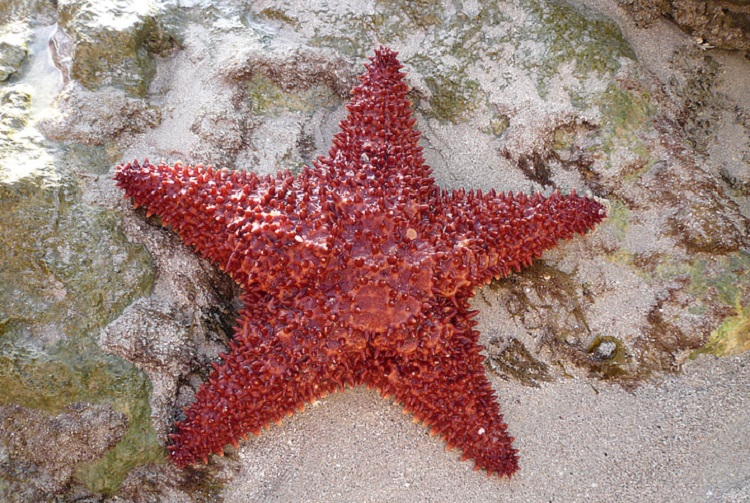Overview
It’s thought there are around 2,000 species of starfish living in every one of the world’s oceans, from the tropical Caribbean to the frigid depths of the Arctic. So, if, like me, you love beachcombing; you’ve most likely come across a stranded starfish or seen one in a rockpool.
Did you know that starfish, or Asteroidea to give the animal its scientific name, are not fish at all? These amazing creatures are echinoderms and closely related to sand dollars and sea urchins.
For that reason, marine scientists have recently corrected that misnomer by referring to starfish as “sea stars,” although the two are the same animal.
Want more fascinating facts about the remarkable sea star? Let’s explore!
Natural History
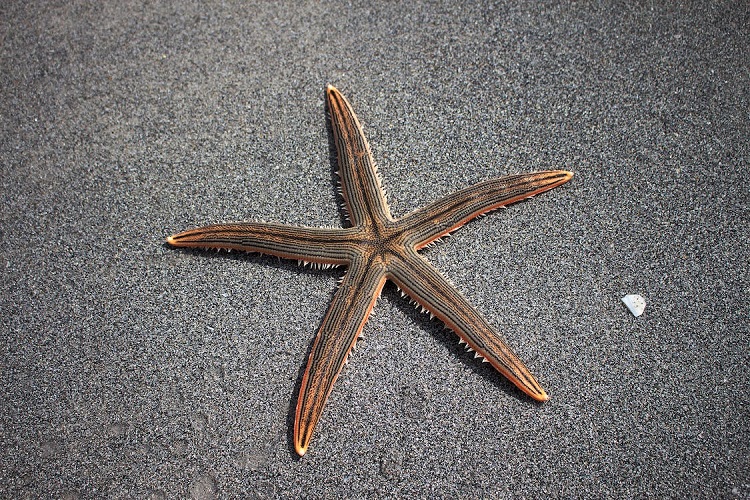
Belonging to the phylum Echinodermata, starfish have been around for 450 million years, according to fossil records. However, the soft-bodied sea star tends to degrade when it dies, leaving only a few fragile spines behind, making it tricky to work out for just how long these creatures have been on earth.
Today, there are thought to be around 2,000 species of starfish in every ocean on the planet, living in varied habitats from the intertidal zone down to depths of 20,000 feet below the water’s surface.
Starfish are classified as marine invertebrates, having a central disc and five or more arms. Some starfish are brightly colored orange, red, or bright blue to ward off predators, whereas others are darker shades of brown or gray.
Sea stars are carnivorous predatory hunters, feeding mostly on benthic invertebrates. These amazing animals can reproduce both asexually and sexually, and they can even regenerate lost arms and be reborn into whole new starfish.
Incredibly, if a sea star is attacked by a predator, it can shed an arm as a means of defense and simply regrow a new one!
Anatomy
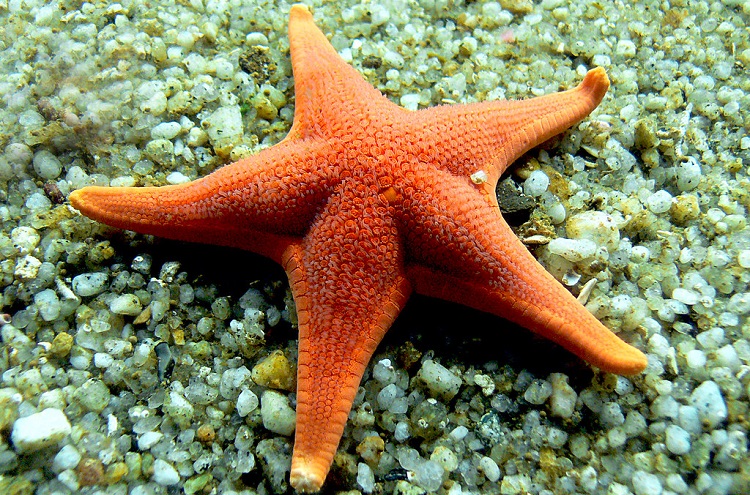
The starfish you’ve seen have usually five arms radiating from the central disc since they are the most common and are where the animal got its common name. However, some species of sea stars exist with ten, 20, and even 40 arms. Now, that’s amazing!
At the end of each arm is a tiny eye called an ocellus that enables the starfish to differentiate between dark and light and to detect movement. They are covered by a thick, transparent cuticle that protects the ocelli and focuses light.
Sea stars have an endoskeleton made from calcium carbonate. Some species, such as the Crown of Thorns, have outer layers of granules or spines.
To one side of the starfish’s central disk is a porous plate called the madreporite, which appears as a faint circle. The madreporite provides additional water for the starfish’s circulatory system, which acts as a blood supply.
Some groups of sea stars have pedicellariae. These tiny valve-like structures are thought to act as a defense mechanism for catching and killing prey or when the animal is feeding.
Digestive System
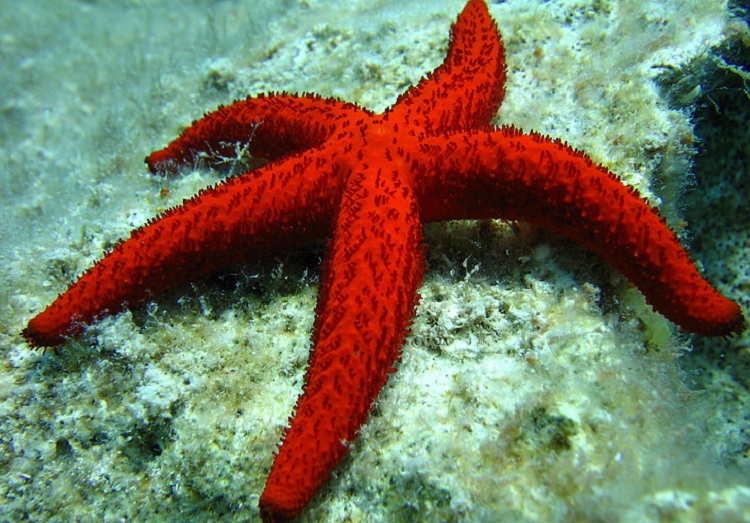
The sea star’s mouth is located on the underside of the body and opens, via a short esophagus, into the animal’s first stomach. A second stomach processes food, which is excreted via the anus on the underside of the body.
Nervous System
Could you live life without a brain? Neither could I. However, the lack of gray matter doesn’t prevent the sea star from enjoying its primitive life!
Instead of a central brain, all echinoderms, including starfish, have a network of interconnecting nerves within and below their skin. Those nerves are sensitive to light, temperature, touch, orientation, and water conditions around the animal.
Moving Around
Starfish have a water-powered hydraulic vascular system that enables the animal to “walk” around on its myriad tiny tube feet that project through openings inside the animal’s endoskeleton.
Impressively, some sea stars can scurry around the sea floor up to 3 miles per hour when hunting!
Life Cycle
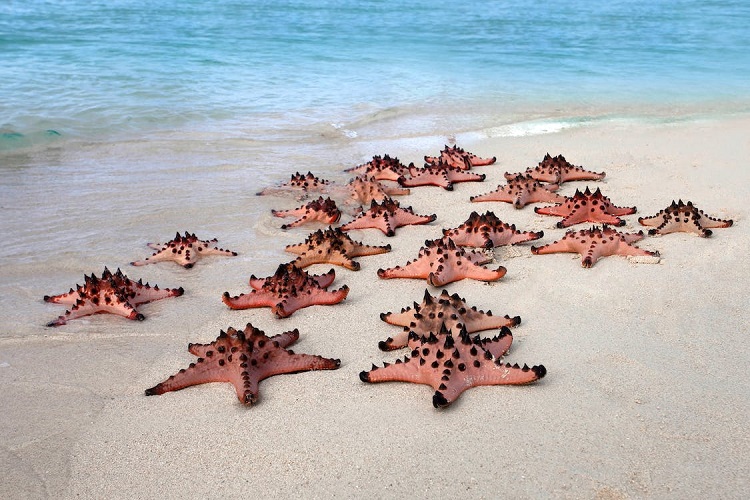
Sea stars have a complex lifecycle. Young starfish larvae remain on the floor of the ocean until they ultimately develop into mature adults. For that reason, it’s virtually impossible to breed starfish in your home marine tank.
Sexual Reproduction
Starfish reproduce sexually through mass spawning, where huge numbers assemble, independently releasing vast clouds of eggs and sperm, and gametes into the water.
Larval Development
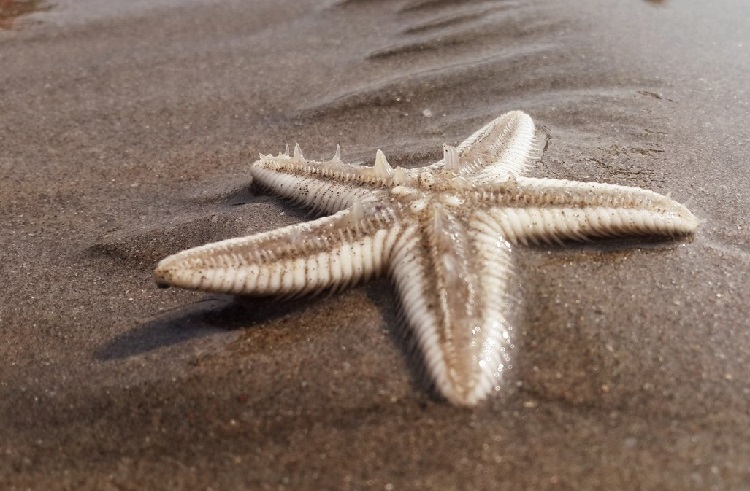
Most species of starfish larvae go through two stages of development on the ocean floor:
Blastula Stage
Initially, the starfish embryos enter the blastula stage. During this stage of development, the baby starfish’s internal organs and systems start to develop, and two arm-like growth eventually emerge.
At this stage, the sea star larvae are known as bipinnaria and feed on phytoplankton that drifts past them on the ocean current.
Brachiolaria
During the second developmental stage, the larvae are called brachiolaria.
The tiny sea stars develop three further short arms before settling on the substrate and securing themselves with a short stalk and a sucker.
Now, the larvae’s tissues rearrange drastically both internally and externally. Finally, the creature casts off its stalk and morphs into a fully-fledged miniature sea star of around 0.04 inches in diameter.
Asexual Reproduction
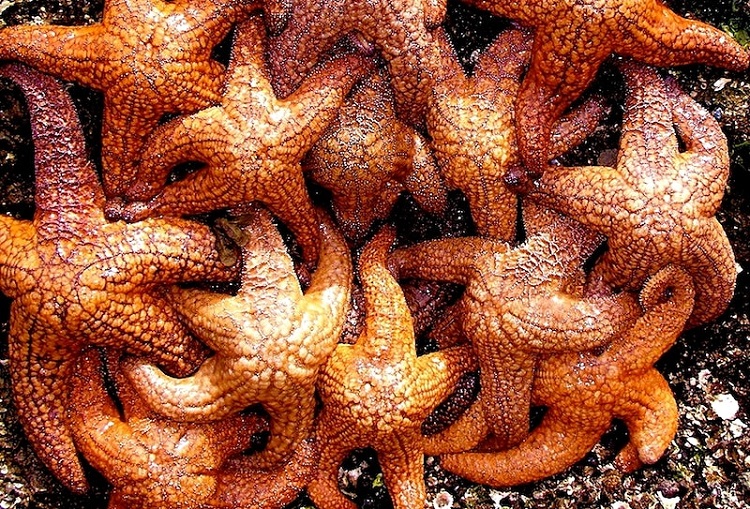
A few starfish varieties in the Asteriidae, Asterinidae and Solasteridae families can reproduce asexually, usually when food is plentiful, and conditions are right.
Basically, the sea star sheds an arm and portion of its central disc, creating a structure called a comet. Eventually, the animal develops into a completely symmetrical, entirely new sea star.
Regeneration
Some sea stars are able to regenerate fallen arms following an accident, and a few can even regrow a new central disc from a single arm, eventually developing their characteristic five-point radial symmetry.
Growing a new arm generally takes several months or even years. During the early stages following the loss of an arm, sea stars are vulnerable to infections. Remarkably, starfish can live on stored nutrients until the animal regrows a mouth and disc and can feed normally again.
Lifespan
Plenty of sea animals will happily make a meal of a sea star, including turtles, crabs, seals, and even other sea stars. So, although starfish can live for up to 35 years, that’s assuming the creature doesn’t get gobbled up by a predator first!
Ecology of Starfish
Starfish have several important ecological roles, some of which are good and some not.
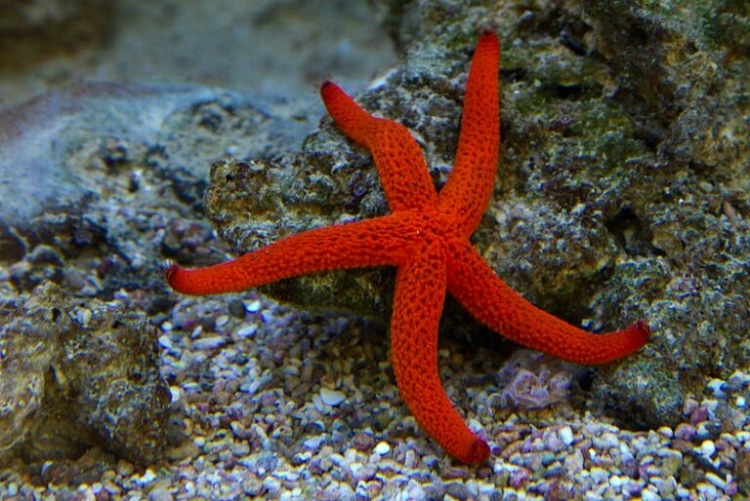
Distribution and Habitat
Starfish and other echinoderms cannot live in freshwater because their complex internal electrolyte balance only works with seawater.
Sea stars inhabit a range of different habitats, including shallow tidal pools, coral reefs, mud and sand substrate, rocky shorelines, kelp forests, and even seagrass meadows.
Unusual Feeding Behavior
Sea stars have a bizarre way of feeding. These weird animals turn their stomachs out of their mouths and then digest their meal outside of their body. Yuk!
Ecological Impact

Sea stars are an excellent example of a keystone species and can have a massive ecological impact on their environment.
For example, in some areas, sea stars help to control the population of other species, such as sea urchins. If there’s a decrease in starfish numbers, the sea urchin population explodes. The sea urchins then wreak havoc on kelp forests by overgrazing.
Kelp is an important ocean habitat that works to balance the environment by reducing carbon and pollution levels.
However, other sea stars like the Crown of Thorns starfish are voracious coral predators. Consequently, in the Indo-Pacific oceans, these starfish are considered one of the planet’s top 100 invasive species.
Threats
Although sea stars are widely distributed, their numbers are threatened by pollution, a reduction in certain habitats, including coral reefs, and changes in water temperature due to climate change.
However, the primary threat to starfish is thought to be SSW or Sea Star Wasting disease. In fact, in 2013, a mass sea star mortality event caused a significant decline in Northeastern Pacific starfish populations.
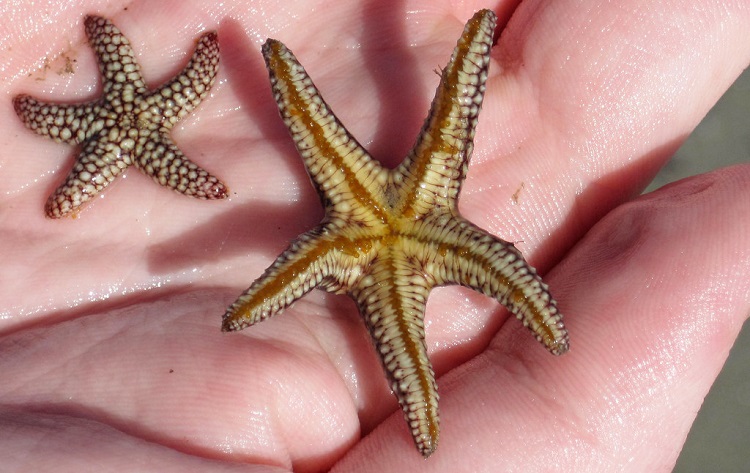
Starfish As Predators
Starfish are predatory hunters, preying on a wide variety of creatures, including clams, mussels, scallops, sea urchins, small fish, and oysters.
If you’re wondering how a sea star attacks its victim, the creature runs down the hapless prey and uses its powerful tube legs to open a mollusk’s shell. Once the clam or scallop’s tasty flesh is exposed, the starfish slips its stomach inside the prey and starts eating.
Starfish Population
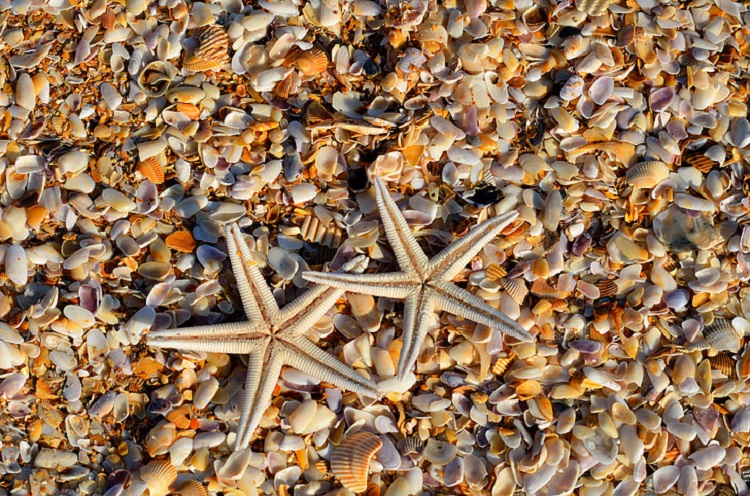
Starfish populations around the world are generally thought to be healthy.
However, Sunflower sea stars that range along the Pacific Coast from Mexico to California to Alaska could be on the verge of extinction.
The International Union for Conservation of Nature (IUCN) cited a 90% decline in species numbers worldwide and placed the Sunflower sea star on the Red List of Threatened Species as critically endangered.
Surprising Facts About Starfish
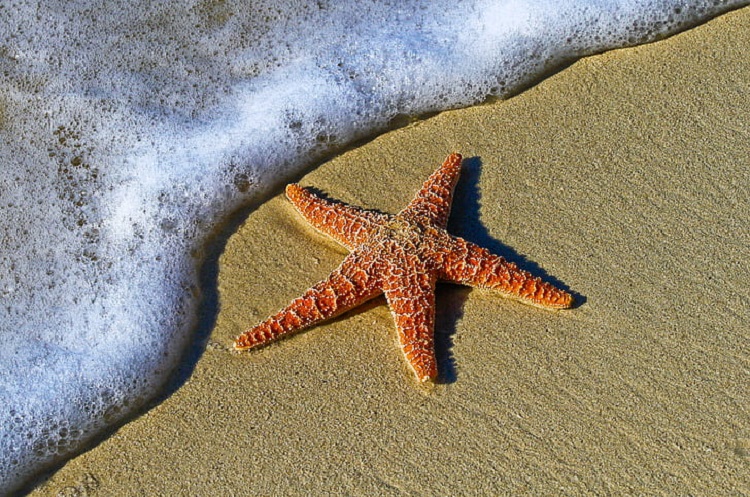
I’m sure you agree that sea stars are remarkable animals. But here are a few surprising facts about starfish that you can use to impress your friends!
- Starfish do not have blood or a brain.
- Even though most starfish look small, they can weigh an impressive 11 pounds.
- Mass strandings of starfish happen regularly, especially during winter following storms.
Sea Stars Are Not Fish!
Starfish do not have fins or gills. For that reason, marine scientists have not included them in the fish category.
Sea Stars Are Echinoderms
These amazing creatures are echinoderms and closely related to sand dollars, sea cucumbers, and sea urchins.
Sea Stars Can Regenerate Arms!
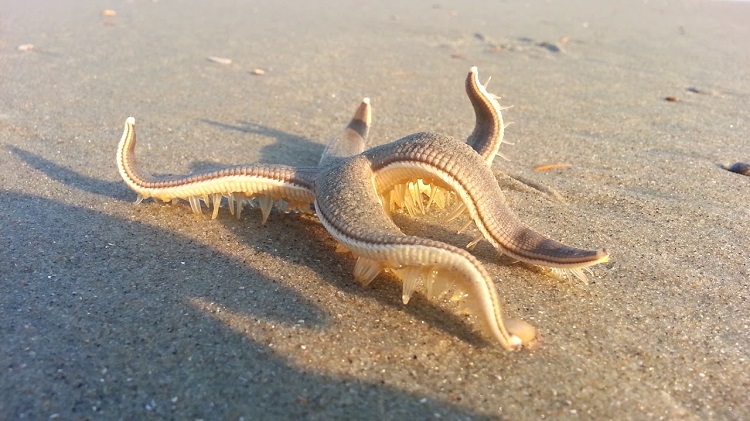
Some species of sea stars can grow another arm if one is damaged. In addition, if the animal is grabbed by a predator, it can shed the snagged arm to escape.
A new arm takes a few months to a couple of years to regrow and is possible because each arm contains elements of the sea star’s vital organs, including the reproductive organs and digestive tract.
Starfish Importance in Ecosystem
Starfish prey on creatures that have no other natural predators. So, if the sea star is absent in the environment, their prey numbers will increase, driving out other species.
In addition, starfish provide diet and shelter for many other creatures, and their scavenging habit helps to keep the seabed clean.
Starfish Classification
There are seven groups of sea stars currently living, including:
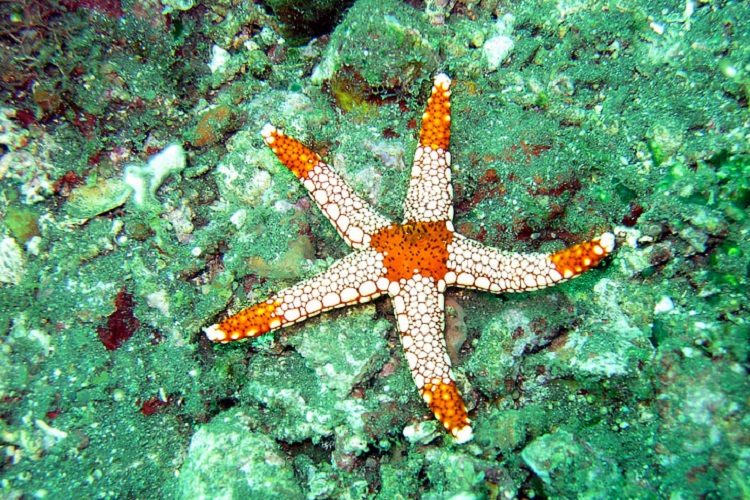
Brisingida
Starfish, in this order, generally have between six and 20 arms. These sea stars are pretty much always found in the deep ocean, although a few live in the shallower waters of the Antarctic.
Forcipulatida
There are 269 species of sea stars belonging to this group, including ones that are commonly found in rock pools on the North Atlantic coast.
Notomyotida
There are 75 species of Notomyotida sea stars, which live exclusively in deep water habitats.
Paxillosida
Paxillosida is a primitive order of 372 starfish species that do not have the brachiolaria stage in their larval development. These sea stars mostly inhabit sandy, muddy habitats.
Spinulosida
The 121 species of the Spinulosida group have groups of short spines on their upper body surface for defense against predators.
Valvatida
Valvatida is the most common group, containing 695 species of sea stars.
Velatida
The Velatida group contains 138 species of sea stars, most of which live in deep-sea environments. These starfish have between five and 15 arms, and some have spiny surfaces.
Extinct Groups
There are three known groups of sea stars that have gone extinct.
The Calliasterellidae group disappeared during the Devonian and Carboniferous periods, along with the Palastericus group. Finally, the Trichasteropsida group went extinct in the Triassic period.
Human Relations
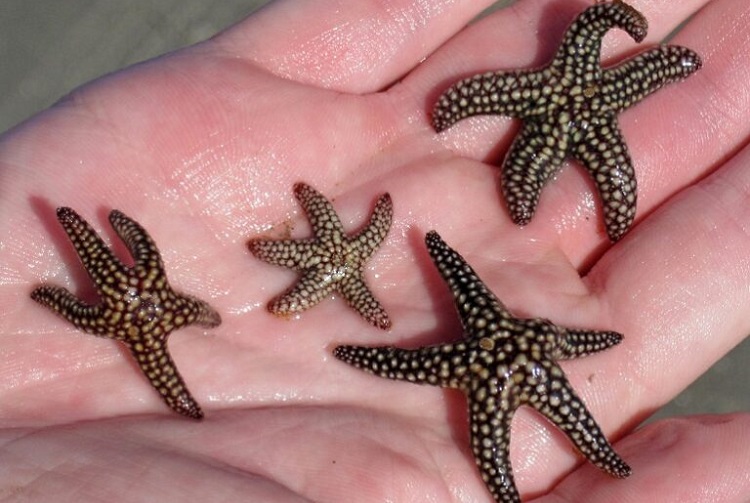
Starfish have long been a source of fascination to humans and feature in several aspects of our lives.
In Research
Starfish are used extensively in research related to reproduction and development.
- Female sea stars produce huge numbers of oocytes (ovarian cells) that can be easily isolated and stored in salt water in a laboratory environment.
- The regrowth, cloning, and repair abilities of starfish are being used in research in human medicine.
Unfortunately, sea stars have a handy ability to reject and expel unwanted foreign objects from their bodies, making the animals challenging to tag and track with researchers.
In Legend and Culture
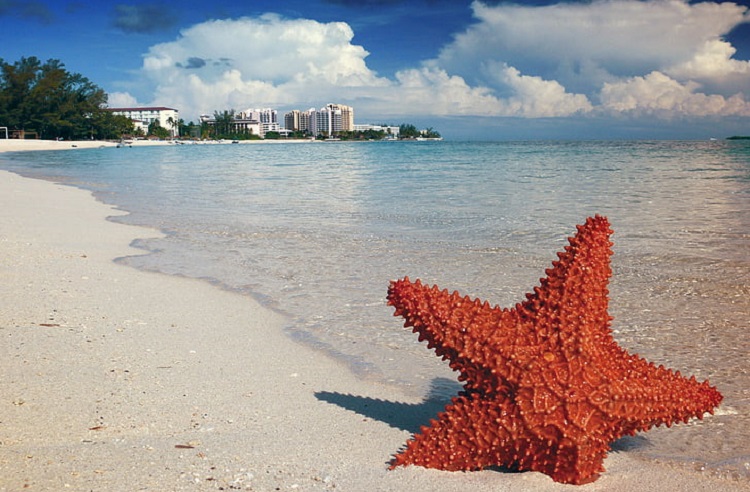
Starfish appear in many myths and legends throughout the centuries.
One example is an old aboriginal fable that tells a tale of how some animals wanted a canoe to cross an ocean. The whale had a canoe but wouldn’t lend it to the other animals.
So, a wily sea star kept the whale busy by picking parasites from his body and telling him stories. Meanwhile, the other animals stole the canoe.
As soon as the whale realized the trick he had fallen for, he beat the starfish ragged, which is why the starfish looks as it does today.
In Christian myths, the sea star represents the Virgin Mary or the Star of the Sea. Similarly, in an Egyptian myth, the sea star is a friend and mother to the enslaved, the impoverished, and anyone in dire need.
The starfish is also said to be a guardian to troubled seafarers and is connected to the Egyptian god, Isis.
Modern Legend of the Starfish
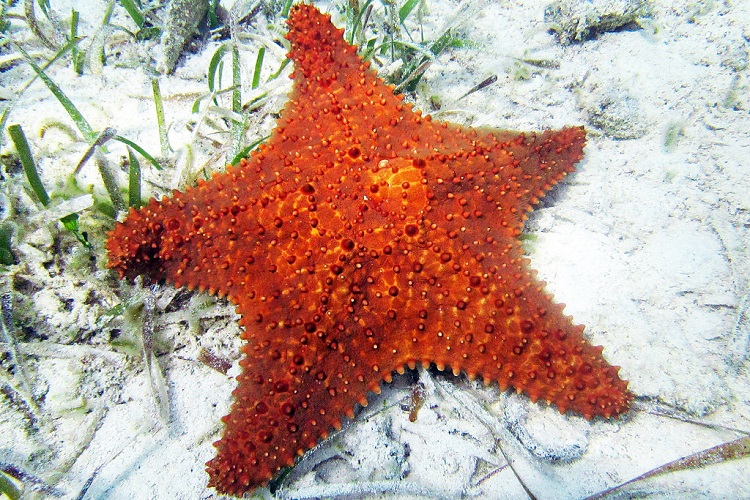
Of all the folk tales and stories involving starfish, my favorite is this one.
One day a man was walking along a beach when he came across a young boy. All along the shoreline were hundreds of starfish that had been beached by the high spring tide and would surely die before the water returned.
The young boy walked slowly along the beach, picking up a beached starfish and gently throwing it back into the ocean.
The man watched the boy for a few moments and decided to teach him a lesson in common sense. Smiling sympathetically, the man approached the boy and said, “Although what you’re doing is admirable, and I can see you have a kind heart, do you know just how many beaches there are along this coast?
There must be hundreds of starfish dying on those beaches every day. Surely, there must be something more profitable for an industrious boy like you to do with your time? Do you really believe what you’re doing can make a difference?”
The boy looked at the man and then looked down at a starfish by his feet. He picked up the beached sea star and gently tossed it back into the safety of the sea. Smiling at the man, the boy said, “It makes a difference to that one.”
As Food
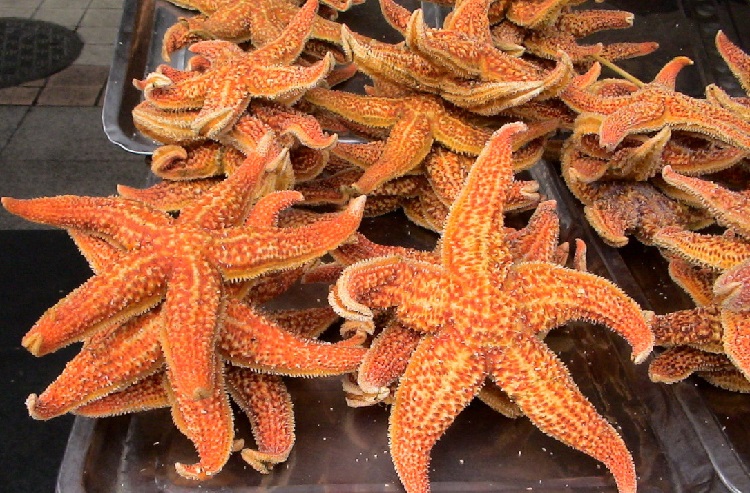
Provided you don’t eat raw sea stars, many species of these animals are edible. In fact, in Thailand, China, Japan, and Indonesia, starfish are regularly sold as street food. Sea stars are usually cooked in boiling saltwater or deep-fried and served on sticks.
However, some species are poisonous, so always eat professionally sourced and prepared sea stars if you want to try them. Apparently, sea stars have a briny, creamy taste that’s unique and not at all like other seafood. I think that’s an acquired taste, and I’ll pass!
As Collectables
If you see dried starfish offered for sale as decorations or tourist souvenirs, we urge you not to buy one.
It could be that those sea stars were found already dead, but it’s more likely they were harvested live. Not only is removing the animals from their natural environment cruel, but it’s also harmful to some populations.
For example, Oreaster reticulatus is a Caribbean species of brightly colored sea star that is often collected and offered for sale to visitors as a vacation souvenir.
In the early 20th century, Oreaster reticulatus was common on the coasts of the West Indies. But today, over-harvesting these beautiful creatures has decimated their numbers.
Now in the State of Florida, it’s illegal to collect this sea star species, and it is listed as endangered. In the Indo-Pacific region, Protoreaster nodosus has suffered a similar fate.
In Industry and Military History

The starfish image is often used by computer and software development companies and is also the moniker used by a seabed imaging system and company.
In military history, the HMS Starfish has been adopted as the name of three Royal Navy ships, including an S-Class submarine, an R-Class destroyer, and an A-class destroyer.
In the Blitz of World War II, Starfish sites were the name given to large-scale nighttime decoys developed to simulate burning UK cities. More recently, in 1962, Starfish Prime was the name given to a high-altitude US nuclear test.
FAQs
In this part of our guide to the sea star, we answer some of the most commonly asked questions about these incredible creatures.
Can You Eat Starfish?
Most starfish species are safe and popular street food in parts of Asia, especially Indonesia, Thailand, and China.
However, some species, such as the Crown of Thorns starfish, are toxic and shouldn’t be eaten. Likewise, you can’t eat starfish raw like sushi, as the flesh of the animal is poisonous until cooked.
Can Starfish Live in Freshwater?
Starfish can only live in saltwater environments. The creatures use a water vascular system of seawater instead of blood to pump nutrients around their bodies. If you put a starfish in freshwater, it will die pretty quickly.
How Big Do Starfish Get?
Starfish vary in size from the tiny ½ inch diameter Paddle-Spined sea star to the monster 40-inch diameter Sunflower sea star.
How Many Legs Does a Starfish Have?
Most varieties of starfish have five legs. However, there are species with ten, 20, and even 50 legs.
Final Thoughts
We hope you enjoyed our guide to the fascinating, beautiful sea star.
These incredible creatures can regenerate lost legs, reproduce sexually and asexually, and many varieties are valuable keystone species in the ocean environment.
So, next time you take a stroll along a beach, watch out for beached starfish, and if you see one, please gently toss it back into the ocean!


